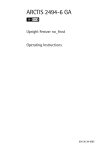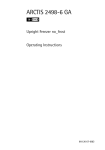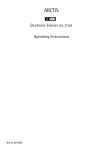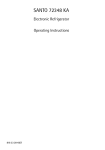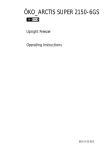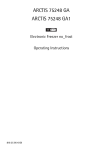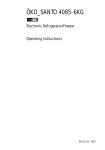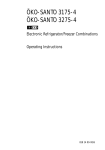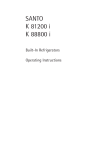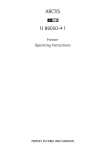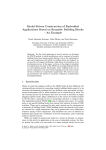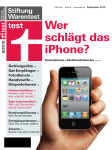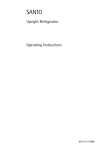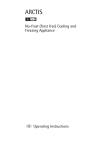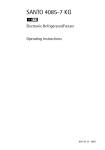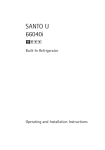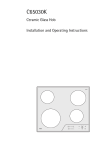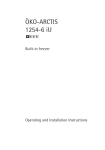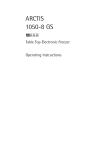Download Electrolux ARCTIS User's Manual
Transcript
ARCTIS Upright Freezer Operating Instructions 818 19 26-00/0 Dear customer, Before placing your new freezer into operation please read these operating instructions carefully. They contain important information for safe use, for installation and for care of the appliance. Please keep these operating instructions for future reference. Pass them on to possible new owners of the appliance. 1 Notes which are important for your safety or for the proper functioning of the appliance are stressed with a warning triangle and/ or with signal words (Warning!, Caution!, Important!). Please observe the following carefully. 0 1. This symbol and numbered instructions guide you step by step in the operation of the appliance. 2. ..... 3 Supplementary information regarding operation and practical applications of the appliance appear after this symbol. 2 Tips and notes concerning economical and environmentally sound use of the appliance are marked with the cloverleaf. Explanations of the technical terminology used in the operating instructions can be found at the end in the section "Technical Terminology". The operating instructions contain instructions for the correction of possible malfunctions by the user in the section "Something not working". If these instructions should not be sufficient, please contact your local AEG Service Force Centre. Printed on paper manufactured with environmentally sound processes. he who thinks ecologically acts accordingly ... 2 818 19 26-00/0 Contents Important Safety Instructions . . . . . . . . . . . . . . . . . . . . . . . . . . . . . . . . . . . 5 Environmental Information . . . . . . . . . . . . . . . . . . . . . . . . . . . . . . . . . . . . . Packaging . . . . . . . . . . . . . . . . . . . . . . . . . . . . . . . . . . . . . . . . . . . . . . . . . . . . . Old Appliances . . . . . . . . . . . . . . . . . . . . . . . . . . . . . . . . . . . . . . . . . . . . . . . . . 7 7 7 Appliance Transport . . . . . . . . . . . . . . . . . . . . . . . . . . . . . . . . . . . . . . . . . . . 7 Before Use . . . . . . . . . . . . . . . . . . . . . . . . . . . . . . . . . . . . . . . . . . . . . . . . . . . . Packaging . . . . . . . . . . . . . . . . . . . . . . . . . . . . . . . . . . . . . . . . . . . . . . . . . . . . . 8 8 Installation . . . . . . . . . . . . . . . . . . . . . . . . . . . . . . . . . . . . . . . . . . . . . . . . . . . 9 Installation Location . . . . . . . . . . . . . . . . . . . . . . . . . . . . . . . . . . . . . . . . . . . . 9 The freezer needs air . . . . . . . . . . . . . . . . . . . . . . . . . . . . . . . . . . . . . . . . . . . . 10 Appliance Alignment . . . . . . . . . . . . . . . . . . . . . . . . . . . . . . . . . . . . . . . . . . . . 10 Electrical Connection . . . . . . . . . . . . . . . . . . . . . . . . . . . . . . . . . . . . . . . . . . . 11 Reversing the door . . . . . . . . . . . . . . . . . . . . . . . . . . . . . . . . . . . . . . . . . . . . 12 Opening the door . . . . . . . . . . . . . . . . . . . . . . . . . . . . . . . . . . . . . . . . . . . . . . 14 Description of the appliance . . . . . . . . . . . . . . . . . . . . . . . . . . . . . . . . . . . . View of the appliance . . . . . . . . . . . . . . . . . . . . . . . . . . . . . . . . . . . . . . . . . . . Freezer tray . . . . . . . . . . . . . . . . . . . . . . . . . . . . . . . . . . . . . . . . . . . . . . . . . . . . Cold accumulation block . . . . . . . . . . . . . . . . . . . . . . . . . . . . . . . . . . . . . . . . Control Panel . . . . . . . . . . . . . . . . . . . . . . . . . . . . . . . . . . . . . . . . . . . . . . . . . . Temperature setting buttons . . . . . . . . . . . . . . . . . . . . . . . . . . . . . . . . . . . . . Temperature display . . . . . . . . . . . . . . . . . . . . . . . . . . . . . . . . . . . . . . . . . . . . FAST FREEZE-button . . . . . . . . . . . . . . . . . . . . . . . . . . . . . . . . . . . . . . . . . . . . 15 15 15 16 16 17 17 18 Prior to Initial Start–Up . . . . . . . . . . . . . . . . . . . . . . . . . . . . . . . . . . . . . . . . 18 Initial use . . . . . . . . . . . . . . . . . . . . . . . . . . . . . . . . . . . . . . . . . . . . . . . . . . . . . 19 Temperature Adjustment . . . . . . . . . . . . . . . . . . . . . . . . . . . . . . . . . . . . . . . 19 Switching the Appliance Off . . . . . . . . . . . . . . . . . . . . . . . . . . . . . . . . . . . . 20 Control and Information Systems . . . . . . . . . . . . . . . . . . . . . . . . . . . . . . . . 21 Temperature Warning . . . . . . . . . . . . . . . . . . . . . . . . . . . . . . . . . . . . . . . . . . . 21 Function Errors . . . . . . . . . . . . . . . . . . . . . . . . . . . . . . . . . . . . . . . . . . . . . . . . . 21 818 19 26-00/0 3 Contents Freezing . . . . . . . . . . . . . . . . . . . . . . . . . . . . . . . . . . . . . . . . . . . . . . . . . . . . . . 22 Frozen Storage . . . . . . . . . . . . . . . . . . . . . . . . . . . . . . . . . . . . . . . . . . . . . . . . 23 Preparation of Ice Cubes . . . . . . . . . . . . . . . . . . . . . . . . . . . . . . . . . . . . . . . 24 Storage Goods Symbols/Freezing Calendar . . . . . . . . . . . . . . . . . . . . . . . . 24 Defrosting . . . . . . . . . . . . . . . . . . . . . . . . . . . . . . . . . . . . . . . . . . . . . . . . . . . . 25 Hints and Tips . . . . . . . . . . . . . . . . . . . . . . . . . . . . . . . . . . . . . . . . . . . . . . . . . Normal Operating Sounds . . . . . . . . . . . . . . . . . . . . . . . . . . . . . . . . . . . . . . . Food Storage . . . . . . . . . . . . . . . . . . . . . . . . . . . . . . . . . . . . . . . . . . . . . . . . . . Energy Saving Advice . . . . . . . . . . . . . . . . . . . . . . . . . . . . . . . . . . . . . . . . . . . 26 26 26 26 Maintenance and Cleaning . . . . . . . . . . . . . . . . . . . . . . . . . . . . . . . . . . . . . 27 Internal Cleaning . . . . . . . . . . . . . . . . . . . . . . . . . . . . . . . . . . . . . . . . . . . . 27 External Cleaning . . . . . . . . . . . . . . . . . . . . . . . . . . . . . . . . . . . . . . . . . . . . 27 Regulations, Standards, Guidelines . . . . . . . . . . . . . . . . . . . . . . . . . . . . . . 27 Something Not Working . . . . . . . . . . . . . . . . . . . . . . . . . . . . . . . . . . . . . . . 28 Technical Terminology . . . . . . . . . . . . . . . . . . . . . . . . . . . . . . . . . . . . . . . . . 29 Guarantee Conditions . . . . . . . . . . . . . . . . . . . . . . . . . . . . . . . . . . . . . . . . . . 30 European Guarantee . . . . . . . . . . . . . . . . . . . . . . . . . . . . . . . . . . . . . . . . . . . . 30 Service & Spare Parts . . . . . . . . . . . . . . . . . . . . . . . . . . . . . . . . . . . . . . . . . . 31 4 818 19 26-00/0 1 Important Safety Instructions These warnings are provided in the interests of your safety. Ensure that you understand them all before installing or using this appliance. Your safety is of paramount importance. If you are unsure about any of the meanings of these warnings contact the Customer Care Department. Prior to Installation • Check the freezer for transport damage. Under no circumstances should a damaged appliance be installed! In the event of damage, please contact your retailer. • • • • • • Installation This appliance is heavy. Care should be taken when moving it. It is dangerous to alter the specifications or attempt to modify this product in any way. Ensure that the appliance does not stand on the electrical supply cable. If the supply cable is damaged, it must be replaced by a cable available from your local Service Force Centre. Any electrical work required to install this appliance should be carried out by a qualified electrician or competent person. Parts which heat up should not be exposed. Whenever possible, the back of the appliance should be close to a wall, but leaving the required distance for ventilation, as stated in the installation instructions. The appliance should be left for 4 hours after installation before it is turned on, in order to allow the refrigerant to settle. Refrigerant The refrigerant isobutane (R600a) is contained within the refrigerant circuit of the appliance, a natural gas with a high level of environmental compatibility, which is nevertheless flammable. • During transportation and installation of the appliance, be certain that none of the components of the refrigerant circuit become damaged. • If the refrigerant circuit should become damaged: – avoid open flames and sources of ignition; – thoroughly ventilate the room in which the appliance is situated. 818 19 26-00/0 5 Important Safety Instructions Child Safety • Do not allow children to tamper with the controls or play with the product. • Keep packaging material away from children! (There is a risk of suffocation!) • • • • • • • • During Use This appliance is designed for domestic use only, specifically for the storage of edible foodstuffs only. It is not intended for commercial or industrial use. Containers with flammable gases or liquids can leak at low temperatures. Do not store any containers with flammable materials such as, spray cans, fire extinguisher refill cartridges etc in the freezer. Frozen food should not be refrozen once it has thawed out. Do not place carbonated or fizzy drinks in the freezer. Ice lollies can cause ’frost/freezer burns’ if consumed straight from the freezer compartment. Do not remove items from the freezer compartment if your hands are damp/wet, as this could cause skin abrasions or frost/freezer burns. Bottles and cans must not be placed in the freezer. They can burst when the contents freeze. Manufacturers´ recommended storage times should be adhered to. Refer to relevant instructions. Maintenance and Cleaning • Before cleaning, always switch off the appliance and disconnect from the electrical supply. • When unplugging always pull the plug from the mains socket, do not pull on the cable. Servicing • This product should be serviced by an authorised engineer and only genuine spare parts should be used. • Under no circumstances should you attempt to repair the appliance yourself. Repairs carried out by inexperienced persons may cause injury or serious malfunctioning. Contact your local AEG Service Force Centre. 6 818 19 26-00/0 Environmental Information Packaging All transit packaging materials are environmentally compatible and can be reused. Wood is un-treated. The plastics can be recycled and are identified as follows: >PE< for polyethylene, e.g. the outer covering and the bags in the interior. >PS< for polystyrene foam, e.g. the pads, which are pure hydrocarbon compounds and can be recycled. The carton parts are made from recycled paper. Please dispose of the packaging with due care for the environment. Old Appliances When disposing of your old appliance: Make the appliance unusable by cutting off the cable and remove any door catches to ensure small children cannot be trapped inside. Help to keep your country tidy - use an authorised disposal site. Appliance Transport Two persons are required for transport of the appliance. There are two recessed handles at the front of the base and at the back of the appliance at the top for improved gripping. 0 1. Grip the appliance with the recessed handles positioned as in the drawing, and transport the appliance. 2. In order to push the appliance into its final position, press carefully at the top of the door and tip the appliance back slightly. The weight is then transferred to the back wheels and the appliance can be easily pushed. 818 19 26-00/0 7 Before Use Packaging 0 1. Remove all adhesive tape and packaging from the interior of the appli- ance. 3 Any remnants of adhesive can be removed with white spirit. 2. Remove the transport protection pieces and pull off the adhesive tape. 3. Wash the inside of the appliance with lukewarm water with a little bicarbonate of soda added (5 ml to 0.5 litre of water). Do not use soap or detergent as the smell may linger. Dry the appliance thoroughly. 8 818 19 26-00/0 Installation Installation Location The appliance should be installed in a well ventilated, dry room. Energy use is affected by the ambient temperature. The appliance should therefore – not be exposed to direct sunlight; – not be installed next to radiators, cookers or other sources of heat; – only be installed at a location whose ambient temperature corresponds to the climate classification, for which the appliance is designed. The climate classification can be found on the rating plate, which is located at the left on the inside of the appliance. The following table shows which ambient temperature is correct for each climate classification: Climate classification for an ambient temperature of SN +10 to +32 °C N +16 to +32 °C ST +18 to +38 °C T +18 to +43 °C 818 19 26-00/0 9 Installation The freezer needs air Air is fed under the door through the vent slots in the base and is exhausted upwards along the back wall. To ensure proper air circulation never cover or alter the vent openings. Important! If the appliance is installed under, for example, a hanging cabinet, a clearance of at least 10 cm between the top of the appliance and the cabinet above it must be maintained. Please check whether, after installing your appliance and especially after reversing the door, the door seal fits tightly. A badly fitting door seal may lead to heavy frosting and a higher power consumption (see also “Something not working“). Appliance Alignment 0 1. The appliance must be level. Please compensate for unevenness in the floor by turning the two adjustable feet at the front. 2. When two appliances are placed beside each other, the spacers enclosed in the plastic wrapping should be glued between the appliances as shown in the illustration. 10 818 19 26-00/0 Installation Electrical Connection Any electrical work required to install this appliance should be carried out by a qualified electrician or competent person. 1 WARNING – THIS APPLIANCE MUST BE EARTHED The manufacturer declines any liability should these safety measures not be observed. Before switching on, make sure the electricity supply voltage is the same as that indicated on the appliance rating plate. The rating plate is inside, on the left. The appliance is supplied with a 13 amp plug fitted. In the event of having to change the fuse in the plug supplied, a 13 amp ASTA approved (BS 1362) fuse must be used. Important The wires in the mains lead are coloured in accordance with the following code: Green Green and Yellow Earth & Yellow Blue Neutral Brown Live As the colours of the wires in the mains lead of this appliance may not correspond with the coloured markings indentifying the termiBrown Blue nals in your plug, proceed as follows: 1. The wire coloured green and yellow must be connected to Cord Clamp the terminal marked with the letter “E“ or by the earth symbol or coloured green and yellow. 2. The wire coloured blue must be connected to the terminal “N“ or coloured black. 3. The wire coloured brown must be connected to the terminal marked “L“ or coloured red. 4. Upon completion there must be not cut, or stray strands of wire present and the cord clamp must be secure over the outer sheat. 1 Warning! A cut-off plug inserted into a 13 amp socket is a serious safety (shock) hazard. Ensure that the cut-off plug is disposed of safely. 818 19 26-00/0 11 Reversing the door The door hinges can be changed from right (as supplied) to left if required to suit the location where the appliance is installed. 1 Warning! Unplug from the mains before reversing the door. Open the door and remove the plinth cover to the front. Move the door bearing cover on the plinth cover from the left to the right. Close the door. 0 1. With the door closed, remove the cross-head screws from the lower door bearing and remove the door bearing downwards. 2. Remove the door fitting from the door bearing (1, 2). Move the bearing pivot from the right to the left hand hole (3). Place the door fitting supplied on the bearing pivot (4, 5). 1 4 5 2 3 12 818 19 26-00/0 Reversing the door 3. Remove the door fitting on the lower right (1) and reposition the door bearing cover from the lower left to the right of the door (2), place the door fitting supplied in the lower left of the door (3). Carefully remove the door to the front and place on one side. 4. Move the upper bearing pivot to the left. 5. Carefully slide the door onto the top bearing pivot and close. 6. Place the lower door bearing with the bearing pivot in the lower left of the door and fasten. 818 19 26-00/0 13 7. Move the door handle from the left to the right and cover the remaining holes with the hole cover pins attached. 8. Open the door and fit the plinth cover. Opening the door If the door is closed when the appliance is in operation, it cannot be immediately opened again, because a vacuum occurs which holds the door closed until pressure has been equalised. The door can be opened again after several minutes. If your appliance is equipped with a QUICK door opener - an opening mechanism integrated into the door handle the door can be opened easily at any time. 14 818 19 26-00/0 Description of the appliance View of the appliance (various models) Freezer tray with ice cube trays and cold accumulation block Compartments with lids and drawers (for storage and freezing) Drawer (for frozen food storage only) The bottom drawer also serves as a water collector when defrosting Freezer tray A freezer tray with two ice cube trays and one cold accumulation block is inserted at the very top of the freezer compartment. 3 Berries, for example, can be pre-frozen on the freezer tray. Advantage: The berries are not squashed and maintain their natural form. The frozen berries can then be stored in compartments or drawers packaged in individual portions. 818 19 26-00/0 15 Description of the appliance Cold accumulation block There is one cold accumulation block in the freezer tray. Refer to the section “Prior to Initial Start–Up” concerning freezing of the cold accumulation block. 3 In the event of a power failure or malfunction, the cold accumulation block will increase the hold over period by several hours, providing it is placed in the uppermost drawer, at the front, above the frozen food. You can also use the cold accumulation block in a cool bag. Control Panel 1 2 3 4 5 6 ON/OFF indicator light (green) ON/OFF button Temperature display Temperature setting buttons FAST FREEZE indicator light (yellow) FAST FREEZE button • FAST FREEZE for fast freezing fresh food 7 Warning indicator light (red) 8 WARNING OFF button (see section: "Control and Information Systems") 16 818 19 26-00/0 Description of the appliance Temperature setting buttons The temperature is adjusted using the „+“ (WARMER) and „-“ (COLDER) buttons. These buttons are connected to the temperature display. • The temperature display is switched over from the display of the ACTUAL temperature (one light illuminated) to the display of the DESIRED temperature (one light flashing) by pressing one of the two buttons, „+“ (WARMER) or „-“ (COLDER). • With each further press of one of the two buttons, the DESIRED temperature is adjusted by one display field. • If neither button is pressed, the temperature display automatically switches back after a short period (approx. 5 sec.) to the display of the ACTUAL temperature. DESIRED temperature means: The temperature that is required in the freezer compartment, this can be adjusted to the temperatures shown in the display. The DESIRED temperature is indicated by a flashing light. ACTUAL temperature means: The temperature display indicates the temperature that is currently present in the freezer compartment. The ACTUAL temperature is indicated by a continuously illuminated light. Temperature display The temperature display can indicate several pieces of information. • During normal operation, the temperature currently present in the appliance (ACTUAL temperature) is displayed, the corresponding light illuminates. • If the temperature in the freezer compartment is warmer than the display range of the temperature display, the red warning light flashes and all the lights in the temperature display are extinguished. • If the temperature in the freezer compartment is colder than the display range of the temperature display, then the light for the lowest temperature (-24) continues to illuminate. • When the temperature is being adjusted, the temperature currently set flashes (DESIRED temperature). • If there is a malfunction in the appliance that prevents the temperature from being further measured, all the lights on the temperature display flash. 818 19 26-00/0 17 FAST FREEZE-button The FAST FREEZE function provides for quick freezing of fresh food products, and at the same time protects previously stored goods against undesired warming in the freezer compartment. 0 1. The FAST FREEZE function is switched on by pressing the FAST FREEZE button. The yellow light illuminates. 2. The FAST FREEZE function can be ended manually at any time by pressing the FAST FREEZE button again. The yellow light goes out. If the FAST FREEZE function is not ended manually, the appliance electronics switch off the FAST FREEZE function after 48 hours. The yellow light goes out. Prior to Initial Start–Up 1 Before connecting the appliance to the mains and putting it into operation for the first time, leave the appliance to stand for 30 minutes if was transported upright. After transport on its side, the appliance must be left to stand for 4 hours before putting it into operation. This is necessary to allow the refrigerant to flow back into the compressor. Otherwise the compressor may be damaged. 0 1. Please clean the appliance interior and all accessories prior to initial start-up (see section: “Maintenance and Cleaning”). 2. Remove the cold accumulation block from the appliance. 3. Only put the cold accumulation block to freeze in the top compartment after the optimal storage temperature of –18 °C has been reached. 4. After 24 hours place the cold accumulation block in the uppermost compartment, at the front, above the frozen food. 5. Re-freeze the thawed cold accumulation block in the same way, e. g. after cleaning the appliance. 18 818 19 26-00/0 Initial use 0 1. Insert plug into mains socket. 2. Press ON/OFF button. The green pilot light illuminates. The compressor starts and then runs automatically. A warning tone sounds and the red warning light flashes indicating that the required storage temperature has not yet been reached. 3. Press the WARNING OFF button to switch off the warning tone. 4. Set temperature to -18°C or colder (see section: "Temperature Adjustment"). Important! Wait until the freezer compartment has reached a temperature of –18 °C, or the red warning light has gone out, before storing frozen food. Temperature Adjustment 0 1. Press either the „+“ (WARMER) or „-“ (COLDER) button. The temperature display switches over and the DESIRED temperature currently set flashes on the temperature display. 2. To adjust to a warmer temperature, press the „+“ button. To adjust to a colder temperature, press the „-“ button. The changed setting is immediately displayed on the temperature display. The temperature is adjusted by one display field with each press of a button. Note: From a food safety point of view, -18 °C for the freezer compartment should be considered cold enough as a storage temperature. 3 If the buttons are not pressed again for approx. 5 seconds the temperature display will change from the DESIRED temperature to the ACTUAL temperature. The display changes from flashing to continuous illumination. Important! Please check red warning display and temperature display regularly to assure maintenance of the storage temperature. 818 19 26-00/0 19 Switching the Appliance Off 0 1. To switch off, press the ON/OFF button until the mains power light extinguishes. Note: The appliance cannot be switched on or off if unplugged, or if there is no power being supplied to it. Following connection to the mains power supply, the appliance returns to the same operating state as before the interruption of main power. If the appliance is not going to be used for an extended period: 0 1. Switch off the appliance, to do this press the ON/OFF button until the mains power light extinguishes. 2. Unplug or switch off at the mains supply. 3. Defrost freezer compartment and clean thoroughly (see section: "Maintenance and Cleaning"). 4. Leave door open after defrosting to avoid accumulation of odours. 20 818 19 26-00/0 Control and Information Systems The control and information systems consist of the temperature display, an optical warning display and an acoustic warning. The system warns if: – if the temperature in the freezer compartment is too warm; – functional disturbances at the appliance. Temperature Warning The red warning display flashes and an audible warning sounds, as soon as the temperature in the freezer compartment is warmer than -12 °C. A rise in temperature may be caused by: – frequent door opening for long periods of time; – loading with large quantities of warm foods; – high ambient temperature; – an error with the appliance. The audible warning can be switched off with the WARNING OFF button. Both warning display and audible warning are automatically switched off, when the ACTUAL temperature in the freezer compartment falls to the range of the display. 3 The warning tone switches off automatically after one hour, even if the ACTUAL temperature is still at a variance with the DESIRED temperature. The red warning light continues to flash. Function Errors If the electronics in the appliance have detected a fault that prevents the ACTUAL temperature being measured, all the lights in the temperature display will flash. The appliance will continue to function using a backup programme until a Service Force engineer has repaired the appliance. 818 19 26-00/0 21 Freezing Except for the bottom drawer, which serves for storage purposes, all compartments and drawers are suited for freezing. Important! • The temperature in the freezer compartment must be –18 °C or colder before freezing food. • Please observe the freezing capacity given on the rating plate. The freezing capacity is the maximum quantity of fresh food that can be frozen within a period of 24 hours. If you wish to freeze food several days in a row, please observe a maximum capacity of only 2/3 to 3/4 of that on the rating plate. • Allow warm food to cool down before freezing. The warmth will cause increased ice formation and increase the power consumption. • When freezing large quantities of food, place the frozen cold accumulation block at the front into the top compartment in the freezing chamber. • Thawed foods which have not been processed further (cooked into meals) may not under any circumstances be frozen a second time. 0 1. When freezing maximum capacity press the FAST FREEZE button 24 hours prior to freezing, or 4 to 6 hours for smaller quantities. Yellow indicator light illuminates. 3 The FAST FREEZE button need not be pressed for freezing of small quantities of up to 3 kg. 2. All foods must be packed air tight prior to freezing, so that they do not dry out or lose their flavour, and so that no flavour contamination of other frozen goods occurs. Caution! Do not touch frozen food with wet hands. Your hands could freeze to the food. 3. Place the packed food in the drawers. Unfrozen food must not touch items already frozen, otherwise the frozen food could begin to defrost. 3 22 The appliance electronics automatically switch the FAST FREEZE function off after a period of 48 hours. Yellow indicator light goes out. You can also stop the FAST FREEZE function manually by pressing the FAST FREEZE button again. 818 19 26-00/0 Tips: • The following are suited for the packaging of frozen goods: – freezer bags and polyethylene wraps; – plastic containers for frozen goods; – extra–thick aluminium foil. • The following are suitable for sealing bags and wrap: plastic clips, rubber bands or tape. • Smooth the air out of the bag before sealing; air makes it easier for the frozen food to dry out. • Make flat packages, because these freeze more quickly. • Do not fill plastic containers for frozen goods to the brim with liquid or paste–like goods, because liquids expand during freezing. Frozen Storage Important! Wait until the necessary storage temperature of –18 °C has been reached before storing food already frozen. • Load the freezer only with packaged frozen goods, so that they do not dry out or lose their flavour, and so that no flavour contamination of other frozen goods can occur. • Please observe maximum storage times and expiry dates of frozen goods. 2 Place frozen foods in the drawers sorted by type, as far as possible. This will give you a better overview of the contents, avoid extended door opening and therefore save electricity. 818 19 26-00/0 23 Preparation of Ice Cubes 0 1. Fill the ice cube tray 3/4 full with cold water, place it in the freezer and leave to freeze. 2. To loosen the frozen cubes, either bend the ice cube tray or hold it under running water for a few seconds. Important! Never try to free an ice tray that is frozen to the freezer compartment using pointed or sharp edged objects. Use a soft plastic scraper. Storage Goods Symbols/Freezing Calendar • The symbols on the drawers show different types of frozen goods. • The numbers indicate storage times in months for the appropriate types of frozen goods. Whether the upper or lower value of the indicated storage time is valid depends on the quality of the foods and pre-treating before freezing. The lower value applies to foods with high fat content. 24 818 19 26-00/0 Defrosting During use and when the door is opened, moisture is deposited as frost inside the appliance, particularly on the evaporator. This frost must be removed from time to time using a soft plastic scraper. Under no circumstances use hard or pointed objects for this purpose. The freezer compartment should always be defrosted when the layer of frost has reached a thickness of approx. 4 millimetres; however at least once a year. A good time for defrosting is when the appliance is empty or contains little food. 1 Warning! • Do not use electrical heating appliances or any other mechanical or artificial devices to speed up the defrosting process, with the exception of those recommended in these operating instructions. • Do not use defrosting sprays, they can be hazardous to your health and/or contain substances that damage plastics. 0 1. If large quantities of frozen goods are in storage, press the FAST FREEZE button about 12 hours prior to defrosting, so that the frozen goods can build up a sufficient chill reserve. Caution! Do not touch frozen food with wet hands. Your hands could freeze to the food. 2. Remove frozen food, wrap it in several layers of newspaper and store it, covered, in a cool place. 3. Unplug or switch off at the mains. 4. Remove all the drawers. Remove the pedestal cover (see "Reversing the door" section). Place the bottom drawer directly in front of the appliance to collect the water from defrosting and pull out the water drain conduit. Tip: In order to speed up the defrosting process, place a pot of hot water in the freezer compartment. In addition, remove pieces of ice that break away before defrosting is complete. 5. After defrosting, thoroughly clean the freezer compartment and interior fittings ( see "Maintenance and Cleaning" section). 818 19 26-00/0 25 Hints and Tips Normal Operating Sounds • You may hear faint gurgling or bubbling sounds when the refrigerant is pumped through the coils or tubing at the rear, to the cooling plate/evaporator. • When the compressor is on, the refrigerant is being pumped round and you will hear a whirring sound or pulsating noise from the compressor. • A thermostat controls the compressor and you will hear a faint click when the thermostat cuts in and out. Food Storage To obtain the best performance from your freezer: • Do not store warm food or evaporating liquids. • Do not store food uncovered. • Keep the time between buying chilled food and placing it in your freezer as short as possible. • Do not push food together too much, try to allow air to circulate around each item. 2 Energy Saving Advice • Do not install the appliance close to sources of heat, such as a cooker, dishwasher or radiator. • Locate the appliance in a cool well ventilated room and make sure that the air openings of the appliance are not obstructed. • Always leave warm food to cool down to room temperature before placing in the freezer. • Try to avoid keeping the door open for long periods or opening the door too frequently as warm air will enter the cabinet and cause the compressor to switch on unnecessarily often. • Ensure there are no obstructions preventing the door from closing properly. 26 818 19 26-00/0 Maintenance and Cleaning Before any maintenance or cleaning work is carried out DISCONNECT the appliance from the ELECTRICITY supply. Internal Cleaning 0 1. Defrost the freezer compartment (see section: "Defrosting"). 2. Clean the inside and accessories with warm water and bicarbonate of soda (5 ml to 0.5 litre of water). Rinse and dry thoroughly. 1 Warning! • Do not use detergents, abrasive powders, highly perfumed cleaning products, wax polishes or cleaning products containing bleach or alcohol. 3. Regularly check the door seals and wipe clean to ensure they are clean and free from debris. External Cleaning 0 1. Wash the outer cabinet with warm soapy water. 1 Warning! • Do not use abrasive products • There are sharp edges on the underside of the product so care should be taken when cleaning. 2 Accumulation of dust at the condenser increases energy consumption. For this reason carefully clean the condenser at the back of the appliance once a year with a soft brush or a vacuum cleaner. Regulations, Standards, Guidelines This appliance was designed for household use and was manufactured in accordance with the appropriate standards. The necessary measures in accordance with appliance safety legislation regulations (GSG), accident prevention regulations for refrigeration appliances (VBG 20) and the regulations of the German Society of Electrical Engineers (VDE) were observed in the manufacture of this appliance. The refrigerant circuit has been checked for leaks. ; This appliance is in accordance with the following EU guidelines: – 73/23/EWG dated 19 February 1973 - low voltage guidelines. – 89/336/EWG dated 3 May 1989 (including guideline change notice 92/31/EWG) - EMV guideline 818 19 26-00/0 27 Something Not Working Before contacting your local Service Force Centre, check the following points. Sympton Solution Check there is power at the socket No power to the appliance. Check there is not a power cut by checking the household lights. Check the fuse has not blown. All the lights in the temperature display are flashing. There is a function error. Inform customer service. Do not open the door of appliance any more. Check the ambient temperature is within the appliances operating limits The temperature in the freezer is too high. Check the temperature regulator is turned to the correct setting relative to ambient conditions. Adjust the temperature regulator to give correct temperature control. Check that the door is closed. The compressor runs continuously Large quantities of food have recently been placed in the cabinet and/or door is frequently opened. Check that air ventilation is not obstructed. 28 Excessive build up of frost. If the door seal is not airtight (probably after reversing the door) apply warm air to the non sealing area using a hair dryer set to a gentle heat. (do not use a fan heater for this purpose). This will make the rubber more supple and allow it to revert to its original shape. Noise Refer to Normal Operating Sounds The compressor does not start immediately after changing the temperature setting. This is normal, the compressor starts after a period of time. 818 19 26-00/0 If after the above checks there is still a fault, call your local AEG Service Force Centre. In-guarantee customers should ensure that the above checks have been made as the engineer will make a charge if the fault is not a mechanical or electrical breakdown. Please note that proof of purchase is required for in-guarantee service calls. Technical Terminology • Refrigerant Liquids that can be used to a generate a cooling effect are known as refrigerants. They have a relatively low boiling-point, indeed so low, that the warmth from the food stored in the fridge or freezer can cause the refrigerant to boil and vaporise. • Refrigerant Circuit Closed circulation system that contains the refrigerant. The refrigerant circuit comprises primarily of an evaporator, a compressor, a condenser and pipe work. • Evaporator The refrigerant is evaporated in the evaporator. Similar to all other liquids, refrigerant requires heat to evaporate. This heat is removed from the interior of the appliance, as a result the interior is cooled. The evaporator is therefore located inside the appliance or placed in foam immediately behind the inner wall and thus not visible. • Compressor The compressor looks like a small drum. It is driven by a built-in electric motor and is mounted on the base of the appliance at the rear. The task of the compressor is to draw in vaporised refrigerant from the evaporator, to compress it, and to pass it on to the condenser. • Condenser The condenser normally has the form of a grid. The refrigerant compressed in the compressor is liquefied in the condenser. During this process, heat is released to the surrounding air at the surface of the condenser. The condenser is mounted on the base of the appliance. 818 19 26-00/0 29 Guarantee Conditions AEG offer the following guarantee to the first purchaser of this appliance. 1. The guarantee is valid for 12 months commencing when the appliance is handed over to the first retail purchaser, which must be verified by purchase invoice or similar documentation. The guarantee does not cover commercial use. 2. The guarantee covers all parts or components which fail due to faulty workmanship or faulty materials. The guarantee does not cover appliances where defects or poor performance are due to misuse, accidental damage, neglect, faulty installation, unauthorised modification or attempted repair, commercial use or failure to observe requirements and recommendations set out in the instruction book. This guarantee does not cover such parts as light bulbs, removable parts of glass or plastic, bags or filters. 3. Should guarantee repairs be necessary the purchaser must inform the nearest customer service office (manufacturer´s service or authorised agent). AEG reserves the right to stipulate the place of the repair (i. e. the customer´s home, place of installation or AEG workshop). 4. The guarantee or free replacement includes both labour and materials. 5. Repairs carried out under guarantee do not extend the guarantee period for the appliance. Parts removed during guarantee repairs become the property of AEG. 6. The purchaser´s statutory rights are not affected by this guarantee. European Guarantee If you should move to another country within Europe then your guarantee moves with you to your new home subject to the following qualifications: – The guarantee starts from the date you first purchased your product. – The guarantee is for the same period and to the same extent for labour and parts as exist in the new country of use for this brand or range of products. – This guarantee relates to you and connot be transferred to another user. – Your new home is within the European Community (EC) or European Free Trade Area. – The product is installed and used in accordance with our instructions and is only used domestically, i. e. a normal household. – The product is installed taking into account regulations in your new country. Before you move please contact your nearest Customer Care Centre, listed below, to give them details of your new home. They will then ensure that the local Service Organisation is aware of your move and able to look after you and your appliances. 30 France Senlis +33 (0) 44 62 29 29 Germany Nürnberg +49 (0) 911 323 2600 Italy Pordenone +39 (0) 1678 47053 Sweden Stockholm +46 (0) 8 738 7910 UK Slough +44 (0) 1753 219899 818 19 26-00/0 Service & Spare Parts If after carrying out the necessary checks there is still a fault with your appliance please contact your local AEG Service Force Centre. In guarantee customers should ensure that the suggested checks have been made as the engineer will make a charge if the fault is not a mechanical or electrical breakdown. Please note that proof of purchase is required for in-guarantee service calls. Service & Spare Parts If you require a service engineer or wish to purchase spare parts, contact your local AEG Service Force Centre, by telephoning 08705 929 929 Help us to help you Please determine your type of enquiry before writing or telephoning. When you contact us we need to know, 1 Your name, address and post code 2 Your telephone number 3 Clear and concise details of the fault 4 Date of purchase 5 • Model Name • Model Number (PNC) • Serial Number (S-No.) This information can be found on the rating plate in the interior of the appliance at the left. Customer Care For general enquiries concerning your AEG appliance, or for further information on AEG products, please contact our Customer Care Department or visit our website at www.aeghome.co.uk AEG Domestic Appliances 55-77 High Street Slough Berkshire SL 1 1DZ Tel: 08705 350350 * * calls to this number may be recorded for training purposes. 818 19 26-00/0 31 AEG Hausgeräte GmbH Postfach 1036 D-90327 Nürnberg http://www.aeg.hausgeraete.de © Copyright by AEG 818 1926 – 00/0 - 0801
































